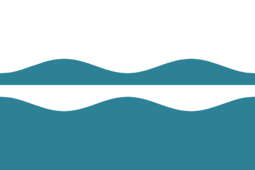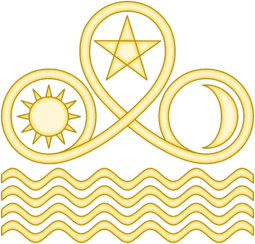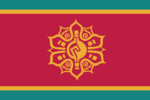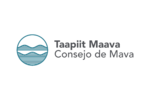Flag and emblem of Mava: Difference between revisions
No edit summary |
(→Flag) |
||
| (55 intermediate revisions by 2 users not shown) | |||
| Line 1: | Line 1: | ||
{{Infobox flag | {{Infobox flag | ||
| Name = Mava | |Name = Flag of Mava | ||
| | |Image = Flag of Mava.png | ||
| | |Alt = Flag of Mava | ||
| Use = | |Use = 111111 | ||
| Proportion = 2:3 | |Symbol = {{FIAV|110010}}{{FIAV|normal}} | ||
| Adoption = | |Proportion = 2:3 | ||
| Design = A horizontal bicolour of white and blue | |Adoption = 10 April 1978 | ||
|Design = A horizontal bicolour of white and blue with a countercharged wave mirrored horizontally. | |||
}} | }} | ||
The flag of Mava | {{Infobox emblem | ||
|name = Emblem of Mava | |||
|image = [[File:Emblem of Mava.png|255px]] | |||
|alt = Emblem of Mava | |||
|year_adopted = 9 March 1981 | |||
|motto = | |||
|torse = | |||
|armiger = [[Mava]] | |||
|shield = Or, Hungerford knot, dexter charged with a sun, middle charged with a mullet, sinister charged with a crescent sinister; upon Waves of Water. | |||
}} | |||
The '''flag and emblem of Mava''' are the state symbols of [[Mava]], an unincorporated territorial area of [[Atitlan]]. The symbols were adopted by [[Mava Council]] in 10 April 1978 and 9 March 1981 respectively and were formally proclaimed in a special session of [[Mava Council]]. | |||
The flag is a public symbol and there are few restrictions on its use. The emblem is used to represent the state authorities and may not be used in a private or commercial capacity. | |||
==Flag== | |||
Until 1978, Mava had no distinctive flag or coat of arms of its own. From its annexation in 1836 the Atitlanese flag and emblem had been used to signify its sovereignty over the islands. Although a number of private, unofficial flags had been used, none were recognised and none enjoyed continued use. In 1972 plans for a new flag were announced by [[Mava Council]], with a competition held to design it. In April 1978 the Council approved the adoption of the ''Kaamatuulikalat'' ("Our Blue Flag"), designed by college student Aalanaq Kukiatok. | |||
The colours and symbols of the flag carry cultural and geographical meanings. The general design, featuring a mirrored wave, symbolises the landscape as seen arriving from the ocean, symbolising the "return home" as well as being a visible reference to the flag's intention to represent the island. The colour scheme also has geographical significance, representing the sea and snow which predominate life in Mava. The design was first described in the Flag Ordinance 1978, with more detailed specifications laid out in the National Symbols (Specifications) Ordinance 1992. | |||
The aspect ratio of its length to breadth is 3:2, the same as the Atitlanese flag. | |||
The flag appears in a stylised form in the logo of [[Mava Council]]. | |||
{{Gallery | |||
|title=Flags of Mava | |||
|align=center | |||
|height=100 | |||
|width=150 | |||
|File:Flag of Atitlán.png | |||
|Flag of Atitlan, the sole official flag until 1978 | |||
|File:Unofficial flag of Mava (until 1978).png | |||
|Unofficial flag used until 1978 | |||
|File:Flag of Mava Council.png | |||
|Flag used by Mava Council | |||
||}} | |||
== | ==Emblem== | ||
The | The '''emblem of Mava''' consists of a three loops (a Hungerford knot), the central loop being higher, each charged with one of the celestial bodies (a sun, a moon, and a star), all of which sits upon five waves. The emblem, designed by Kuulak Muulukit, was adopted in 1981 and draws inspiration from indigenous Mavean artwork. The design is a stylised representation of the Mavean islands (the three loops) and their location in the Sarosan Ocean. The celestial bodies represent the individual Gods who supposedly reigned in each of the islands: the God of Day (representing hope, work, and life), the God of Night (representing war, danger, and death), and the God of the Stars (representing love). | ||
Whilst the laws regulating the emblem do not specify a colour, generally it is presented in gold ("Or"), although other colours are used when gold is inappropriate. | |||
==See also== | ==See also== | ||
* [[Politics of Mava]] | * [[Politics of Mava]] | ||
* Culture of Mava | * Culture of Mava | ||
==External links== | ==External links== | ||
Latest revision as of 14:10, 26 May 2024
 | |
| Use | National flag and ensign |
|---|---|
| Proportion | 2:3 |
| Adopted | 10 April 1978 |
| Design | A horizontal bicolour of white and blue with a countercharged wave mirrored horizontally. |
| Emblem of Mava | |
|---|---|
 | |
| Armiger | Mava |
| Adopted | 9 March 1981 |
| Blazon | Or, Hungerford knot, dexter charged with a sun, middle charged with a mullet, sinister charged with a crescent sinister; upon Waves of Water. |
The flag and emblem of Mava are the state symbols of Mava, an unincorporated territorial area of Atitlan. The symbols were adopted by Mava Council in 10 April 1978 and 9 March 1981 respectively and were formally proclaimed in a special session of Mava Council.
The flag is a public symbol and there are few restrictions on its use. The emblem is used to represent the state authorities and may not be used in a private or commercial capacity.
Flag
Until 1978, Mava had no distinctive flag or coat of arms of its own. From its annexation in 1836 the Atitlanese flag and emblem had been used to signify its sovereignty over the islands. Although a number of private, unofficial flags had been used, none were recognised and none enjoyed continued use. In 1972 plans for a new flag were announced by Mava Council, with a competition held to design it. In April 1978 the Council approved the adoption of the Kaamatuulikalat ("Our Blue Flag"), designed by college student Aalanaq Kukiatok.
The colours and symbols of the flag carry cultural and geographical meanings. The general design, featuring a mirrored wave, symbolises the landscape as seen arriving from the ocean, symbolising the "return home" as well as being a visible reference to the flag's intention to represent the island. The colour scheme also has geographical significance, representing the sea and snow which predominate life in Mava. The design was first described in the Flag Ordinance 1978, with more detailed specifications laid out in the National Symbols (Specifications) Ordinance 1992.
The aspect ratio of its length to breadth is 3:2, the same as the Atitlanese flag.
The flag appears in a stylised form in the logo of Mava Council.
Emblem
The emblem of Mava consists of a three loops (a Hungerford knot), the central loop being higher, each charged with one of the celestial bodies (a sun, a moon, and a star), all of which sits upon five waves. The emblem, designed by Kuulak Muulukit, was adopted in 1981 and draws inspiration from indigenous Mavean artwork. The design is a stylised representation of the Mavean islands (the three loops) and their location in the Sarosan Ocean. The celestial bodies represent the individual Gods who supposedly reigned in each of the islands: the God of Day (representing hope, work, and life), the God of Night (representing war, danger, and death), and the God of the Stars (representing love).
Whilst the laws regulating the emblem do not specify a colour, generally it is presented in gold ("Or"), although other colours are used when gold is inappropriate.
See also
- Politics of Mava
- Culture of Mava
External links
- Flag of Mava. International Flag Database


